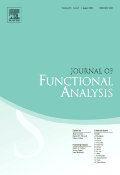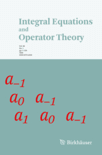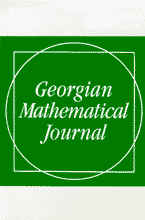
Advances in Operator Theory
Scope & Guideline
Elevating Theoretical Insights in Operator Theory
Introduction
Aims and Scopes
- Operator Theory and Functional Analysis:
The journal emphasizes research on linear operators in Banach and Hilbert spaces, exploring their algebraic and topological properties, and their applications in functional analysis. - Spectral Theory:
A significant focus is placed on spectral analysis, including eigenvalue problems, the spectra of various classes of operators, and the implications of spectral properties on operator behavior. - Matrix Theory and Operator Matrices:
Research on matrix theory, including inequalities, numerical ranges, and operator matrices, is central to the journal, highlighting the interplay between linear algebra and operator theory. - Nonlinear Operators and Differential Equations:
The journal also covers nonlinear operator equations, with applications to partial differential equations and variational problems, reflecting a broader scope of operator theory. - Applications in Quantum Mechanics and Statistical Mechanics:
Theoretical contributions that relate operator theory to quantum mechanics and statistical mechanics are also prevalent, showcasing the interdisciplinary nature of the research. - Approximation Theory and Inequalities:
Research on approximation methods, inequalities associated with operators, and their implications for functional spaces is a consistent theme.
Trending and Emerging
- Noncommutative Operator Theory:
There is an increasing interest in noncommutative aspects of operator theory, including studies on noncommutative Lp spaces and related structures, reflecting broader trends in mathematics. - Operator Algebras and Quantum Theory:
Research that connects operator algebras with quantum mechanics is on the rise, indicating a growing interdisciplinary approach that incorporates physical applications of operator theory. - Numerical Analysis of Operators:
Emerging themes in numerical methods for operator equations and numerical radius inequalities point to a growing interest in computational aspects of operator theory. - Fractional and Nonlinear Operators:
There is a notable trend towards studying fractional operators and their properties, as well as nonlinear operators in various contexts, suggesting a shift towards more complex operator structures. - Applications of Operator Theory to Modern Problems:
The application of operator theory to contemporary issues in mathematical physics, statistics, and engineering reflects a trend toward practical implications and real-world applications.
Declining or Waning
- Classical Operator Theory:
There appears to be a reduced emphasis on classical results in operator theory that have been well-established over the years, such as foundational results on compact and bounded operators. - Elementary Matrix Inequalities:
Research specifically dedicated to elementary matrix inequalities seems to be less frequent, possibly overshadowed by more complex and nuanced operator inequalities. - Basic Functional Analysis:
Basic topics in functional analysis, such as general properties of normed spaces and foundational theorems, are less frequently explored, indicating a shift towards more advanced and specialized topics. - Simple Operator Algebras:
The focus on simpler structures within operator algebras appears to be waning, as the trend seems to favor more complex and abstract algebraic structures.
Similar Journals

CZECHOSLOVAK MATHEMATICAL JOURNAL
Charting New Territories in MathematicsCzechoslovak Mathematical Journal is a distinguished academic journal published by Springer Heidelberg, dedicated to advancing the field of mathematics through the dissemination of high-quality research. With an ISSN of 0011-4642 and E-ISSN 1572-9141, this journal has been a pivotal platform for mathematicians and researchers from around the globe since its inception. The journal holds a Q3 ranking in the field of Mathematics (miscellaneous), demonstrating its commitment to providing a forum for the latest mathematical theories and applications, particularly in general mathematics, as indicated by its Scopus rank of #285/399 and 28th percentile in the field. While currently not offering open access options, the journal continues to attract a wide readership by making its valuable content available through traditional subscription models. The Czechoslovak Mathematical Journal serves as an essential resource for researchers, professionals, and students aiming to stay informed about recent developments and breakthroughs in mathematics, with focus years converging from 1995 to 2024.

Complex Analysis and Operator Theory
Unveiling Insights in Complex AnalysisComplex Analysis and Operator Theory, published by Springer Basel AG, is a renowned journal in the field of applied and computational mathematics, reflecting a strong engagement with contemporary mathematical challenges. With an ISSN of 1661-8254 and E-ISSN 1661-8262, this journal provides a platform for disseminating significant findings and innovative methodologies that contribute to the advancement of complex analysis, operator theory, and their diverse applications. As a valuable resource for researchers and practitioners alike, it features high-quality peer-reviewed articles that rigorously explore both theoretical and practical aspects of mathematics. Although it currently does not offer open access, readers can access its insightful content through institutional subscriptions or individual purchases. Since its inception in 2007, the journal has carved a niche for itself, evidenced by its placement in the Q2 quartiles in both Applied Mathematics and Computational Mathematics, and its recognition in Computational Theory and Mathematics. With an ambitious goal to foster the dialogue between theory and practice, Complex Analysis and Operator Theory continues to support the mathematical community from its base in Basel, Switzerland.

JOURNAL OF FUNCTIONAL ANALYSIS
Shaping the Future of Analysis through Rigorous ResearchThe JOURNAL OF FUNCTIONAL ANALYSIS, published by Academic Press Inc Elsevier Science, stands as a premier platform in the field of analysis, encompassing a broad spectrum of topics pertinent to functional analysis and its applications. With an impressive impact factor and categorized in Q1 for the year 2023, it ranks as one of the top journals in Mathematics (Analysis), placing it in the 77th percentile among its peers. This journal, founded in 1967, continues to provide researchers, professionals, and students with cutting-edge insights, rigorous publications, and a vibrant forum for scholarly discourse. The journal remains committed to advancing knowledge in the discipline and fostering an environment that encourages innovation and collaboration. Although it does not offer open access options, its high standards for publication ensure that each issue is replete with high-quality research that significantly contributes to the field. The journal's comprehensive coverage aligns well with the evolving landscape of functional analysis, making it an indispensable resource for anyone seeking to deepen their understanding and engage with current trends in this essential area of mathematics.

Constructive Mathematical Analysis
Advancing the Frontiers of Constructive Methods in MathematicsConstructive Mathematical Analysis is a distinguished open-access journal dedicated to advancing the field of mathematical analysis, specifically through constructive methods. Published by Tuncer ACAR and affiliated with Selcuk University in Turkey, this journal has been making a significant impact in the academic community since its inception in 2018. With an emerging presence in Scopus, it has earned a Q2 ranking in key categories including Analysis, Applied Mathematics, and Numerical Analysis for 2023, reflecting its commitment to high-quality research contributions. By providing a platform for innovative research and interdisciplinary approaches, "Constructive Mathematical Analysis" aims to facilitate collaboration among researchers, educators, and students in their pursuit of knowledge in mathematical science. With its open-access model, the journal ensures that research findings are accessible to a global audience, fostering an inclusive academic environment.

Annals of Functional Analysis
Exploring Innovations Across Functional Analysis DisciplinesAnnals of Functional Analysis is a distinguished international peer-reviewed journal published by SPRINGER BASEL AG that focuses on the interdisciplinary study of functional analysis, encompassing areas such as algebra and number theory, analysis, and control and optimization. With its ISSN 2639-7390 and E-ISSN 2008-8752, the journal is recognized for its significant contributions to research, currently holding a Q2 ranking in its category as of 2023. Spanning from 2010 to 2024, the journal aims to foster innovation and facilitate collaboration among researchers, professionals, and students by offering open access to high-quality articles and studies that push the boundaries of functional analysis. Based in Iran, Annals of Functional Analysis stands out as an essential platform for advancing the knowledge and application of functional analysis in both theoretical and practical domains, making it an invaluable resource for those dedicated to the field.

Azerbaijan Journal of Mathematics
Elevating Mathematics: Where Research Meets Global ImpactWelcome to the Azerbaijan Journal of Mathematics, a premier academic platform dedicated to the advancement of mathematical research and education. Published by the esteemed Institute of Mathematics and Mechanics of Azerbaijan, this journal presents cutting-edge studies and innovative findings in the field of mathematics since its inception in 2011. With an ISSN of 2218-6816, it has established itself within the top-tier Q2 category of miscellaneous mathematics journals as of 2023, and is ranked #168 out of 399 in the General Mathematics category on Scopus, placing it in the 58th percentile. The journal's commitment to open access benefits a wide audience, making valuable research available to a global community. Covering a diverse range of mathematical disciplines, the Azerbaijan Journal of Mathematics serves as a vital resource for researchers, professionals, and students seeking to enhance their knowledge and contribute to the ongoing discourse in mathematics. Join us in exploring the depths of mathematical thought and application, and be part of our growing community of scholars.

INTEGRAL EQUATIONS AND OPERATOR THEORY
Exploring the depths of integral equations and operator theory.INTEGRAL EQUATIONS AND OPERATOR THEORY, published by SPRINGER BASEL AG, stands at the forefront of research in the fields of algebra, number theory, and analysis, with an esteemed categorization of Q2 in both disciplines as of 2023. With its ISSN 0378-620X and E-ISSN 1420-8989, this journal not only maintains a rigorous standard for scholarly contributions but also offers a vital platform for discourse on theoretical and applied aspects of integral equations and operator theory. Established in 1978, it has nurtured academic growth and innovation, with contributions continuing up to 2024. The journal holds respectable Scopus rankings, placed 43rd out of 119 in Algebra and Number Theory, and 110th out of 193 in Analysis, establishing its relevance and impact within the mathematical community. Researchers, professionals, and students alike will find INTEGRAL EQUATIONS AND OPERATOR THEORY to be an invaluable resource for advancing knowledge, fostering collaboration, and inspiring future studies within these critical areas of mathematics.

Georgian Mathematical Journal
Pioneering insights in diverse mathematical domains.Georgian Mathematical Journal, published by Walter de Gruyter GmbH, is a prestigious academic journal dedicated to the field of mathematics, particularly in its multifaceted applications and theoretical explorations. With an ISSN of 1072-947X and an E-ISSN of 1572-9176, this journal is indexed within notable databases and holds a strong position as evidenced by its Q2 ranking in the Mathematics (miscellaneous) category as of 2023 and a ranking of #140 out of 399 in the general mathematics Scopus category, placing it in the 65th percentile for research visibility. Since its inception in 1994, the journal has continued to evolve, aiming to foster innovative research and scholarly communication among mathematicians worldwide. Although it does not offer Open Access, the journal’s commitment to quality and rigor ensures that published works are of high relevance, appealing to researchers, educators, and students who are dedicated to advancing mathematical knowledge across diverse domains.

Journal of Mathematical Analysis
Innovating the Intersection of Theory and ApplicationThe Journal of Mathematical Analysis, published by UNIV PRISHTINES in Serbia, offers a dedicated platform for the dissemination of innovative research in the fields of mathematical analysis and applied mathematics. With an ISSN of 2217-3412 and a convergence period from 2020 to 2024, this journal aims to foster significant advancements in both theoretical and practical aspects of mathematics. Categorized in the Q4 quartile for Analysis, Applied Mathematics, and miscellaneous Mathematics as of 2023, it serves as an essential resource for researchers and professionals alike, providing key insights into the evolving landscape of mathematical inquiry. Although it is an open access journal, facilitating global readership, its Scopus rankings reflect its emerging status, with rankings indicating a 51st percentile in Mathematics (miscellaneous) and 28th percentile in Applied Mathematics. This journal not only aims to contribute to academic discourse but also seeks to bridge gaps between mathematical theory and real-world applications, making it a vital resource for students and professionals engaged in the complexities of mathematical research.

Electronic Journal of Linear Algebra
Unveiling the Dynamics of Linear Algebra Applications.The Electronic Journal of Linear Algebra, published by the International Linear Algebra Society, is a pivotal platform for research and discourse in the field of linear algebra. With an ISSN of 1537-9582 and an e-ISSN of 1081-3810, this esteemed journal has been disseminating cutting-edge findings since its inception in 1996 and will continue through to 2024. Situated in the United States, at the University of West Florida, the journal has garnered recognition within the academic community, reflected in its Q2 quartile status in Algebra and Number Theory as of 2023, alongside a respectable Scopus rank of #62 out of 119. Although it operates as a non-open access journal, the Electronic Journal of Linear Algebra offers valuable insights and innovative approaches, fostering the development of linear algebra theory and its applications, making it a crucial resource for researchers, professionals, and students alike.